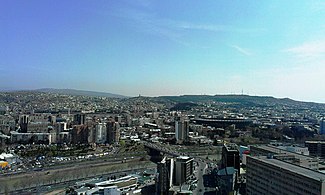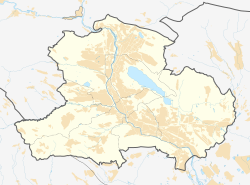
The demographic features of the population of Georgia include population growth, population density, ethnicity, education level, health, economic status, religious affiliations, and other aspects of the population.

Tbilisi, in some languages still known by its pre-1936 name Tiflis, is the capital and the largest city of Georgia, lying on the banks of the Kura River with a population of approximately 1.5 million people. Tbilisi was founded in the 5th century AD by Vakhtang I of Iberia, and since then has served as the capital of various Georgian kingdoms and republics. Between 1801 and 1917, then part of the Russian Empire, Tiflis was the seat of the Imperial Viceroy, governing both Southern and Northern Caucasus.

Georgia is a country located at the intersection of Eastern Europe and Western Asia. It is a part of the Caucasus region, bounded to the west by the Black Sea, to the north and east by Russia, to the south by Turkey and Armenia, and to the southeast by Azerbaijan. It covers 69,700 square kilometres (26,911 sq mi), and has a population of around 4 million. Georgia is a representative democracy governed as a unitary parliamentary republic. Tbilisi is the capital and largest city, home to roughly a quarter of the population.
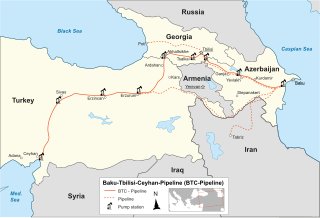
The Baku–Tbilisi–Ceyhan (BTC) pipeline is a 1,768 kilometres (1,099 mi) long crude oil pipeline from the Azeri–Chirag–Gunashli oil field in the Caspian Sea to the Mediterranean Sea. It connects Baku, the capital of Azerbaijan and Ceyhan, a port on the south-eastern Mediterranean coast of Turkey, via Tbilisi, the capital of Georgia. It is the second-longest oil pipeline in the former Soviet Union, after the Druzhba pipeline. The first oil that was pumped from the Baku end of the pipeline reached Ceyhan on 28 May 2006.

Oni is a town in Racha-Lechkhumi and Kvemo Svaneti region (mkhare), Georgia. Historically and ethnographically, it is part of Racha, a historic highland province in western Georgia. The town also serves as an administrative center of the Oni district (raioni).

Narikala is an ancient fortress overlooking Tbilisi, the capital of Georgia, and the Mtkvari River. The fortress consists of two walled sections on a steep hill between the sulfur baths and the botanical gardens of Tbilisi. On the lower court there is the recently restored St Nicholas church. Newly built in 1996–1997, it replaces the original 13th-century church that was destroyed in a fire. The new church is of "prescribed cross" type, having doors on three sides. The internal part of the church is decorated with the frescos showing scenes both from the Bible and history of Georgia.

Guram Kashia is a Georgian professional footballer who plays as a centre-back for and captains the Georgian national team.

The Church of the Red Gospel or Shamkoretsots Sourb Astvatsatsin Church is a ruined 18th century Armenian church in the Avlabar district of Old Tbilisi, Tbilisi, Georgia.

Valeri "Vako" Kazaishvili is a Georgian professional footballer who plays for the Georgia national team as an attacking midfielder.
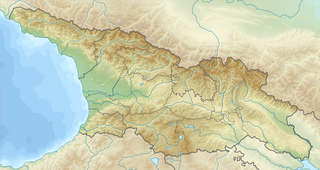
The 2002 Tbilisi earthquake occurred on April 25 in the Caucasus country of Georgia. The United States' National Earthquake Information Center (NEIC) placed the magnitude at 4.3 Ms and 4.8 mb . This moderate magnitude event resulted in a maximum MSK intensity of VII to VIII (Damaging). An independent investigation estimated the total losses at $160 million (US) while the Centre for Research on the Epidemiology of Disasters estimated the total losses at 350 million. Between five and seven were killed, 52–70 were injured, and more than 1,000 were left homeless.

Ivane "Vano" Zodelava was a Georgian politician who served as Mayor of Tbilisi from 10 August 1998 to 19 April 2004.

Gldani-Nadzaladevi is an administrative district (raioni) in Tbilisi, capital of Georgia.
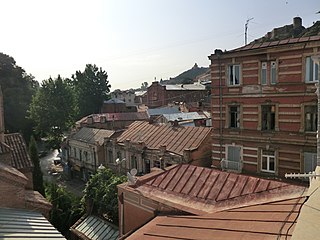
Isani-Samgori is an administrative district (raioni) in Tbilisi, capital of Georgia.
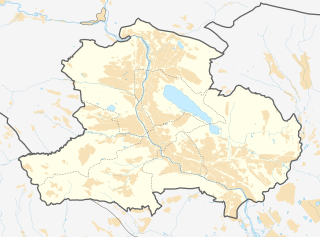
Didgori is an administrative district (raioni) in Tbilisi, capital of Georgia.
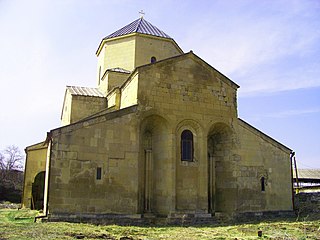
The church of Tsromi is an early medieval church in village Tsromi, in the vicinity of town Khashuri, in Shida Kartli region of Georgia. It is situated at the center of the village, along the right side of the river Mtkvari (Kura).
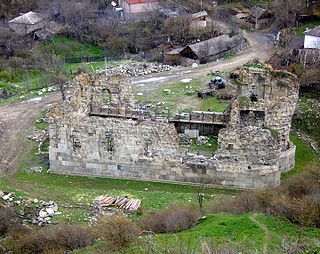
The Atsquri church of the Dormition is a ruined medieval cathedral in the village of Atsquri, Akhaltsikhe Municipality, in Georgia's south-central region of Samtskhe-Javakheti. Originally built in the 10th–11th century, the church was rebuilt shortly after the destructive earthquake of 1283. It was a crossed-dome church with three protruding apses on the east. Of what was one of the largest cathedrals in Georgia in its time, only ruined walls survived into the 21st century. A project of full restoration was launched in 2016. The church is inscribed on the list of the Immovable Cultural Monuments of National Significance of Georgia.
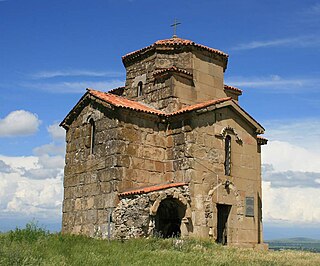
The Samtsevrisi church of Saint George is an early medieval Georgian Orthodox church in the village of Samtsevrisi, Kareli Municipality, in Georgia's region of Shida Kartli. It is a "free-cross" plan church and stylistically dated to the first half of the 7th century. The church is inscribed on the list of the Immovable Cultural Monuments of National Significance of Georgia.

The Martqopi monastery of the Deity is a Georgian Orthodox monastery near the village of Martqopi, some 25 km east of Tbilisi, the capital of Georgia. The history of the monastery dates back to stylite practices in the 6th century and is linked by historical tradition with St. Anton, one of the Thirteen Assyrian Fathers. Most of the monastery's extant structures are from the 17th to the 19th century. The monastery is inscribed on the list of the Immovable Cultural Monuments of National Significance of Georgia.

The Tsirkoli church of the Mother of God is an 8th–9th-century Georgian Orthodox church near the village of Tsirkoli in the Ksani river valley. It combines the features of domeless and domed church designs and is classified as belonging to the "transitional period" of medieval Georgian architecture. The area, part of the Akhalgori Municipality, came under the control of Russian and South Ossetian forces in the August 2008 Russo-Georgian War. As a result the Georgian clergy and parish lost access to the church, which is inscribed on Georgia's Immovable Cultural Monuments of National Significance.

The Jruchi monastery of Saint George is a ruined Georgian Orthodox monastic church in the western Georgian region of Imereti. Founded in the 10th or 11th century, it was remodeled and rebuilt several times until it acquired its final architectural style by 1846. The church was almost completely destroyed in the 1991 Racha earthquake, only a portion of its wall remaining standing amid a rubble. The monastery is inscribed on the list of the Immovable Cultural Monuments of National Significance of Georgia.
